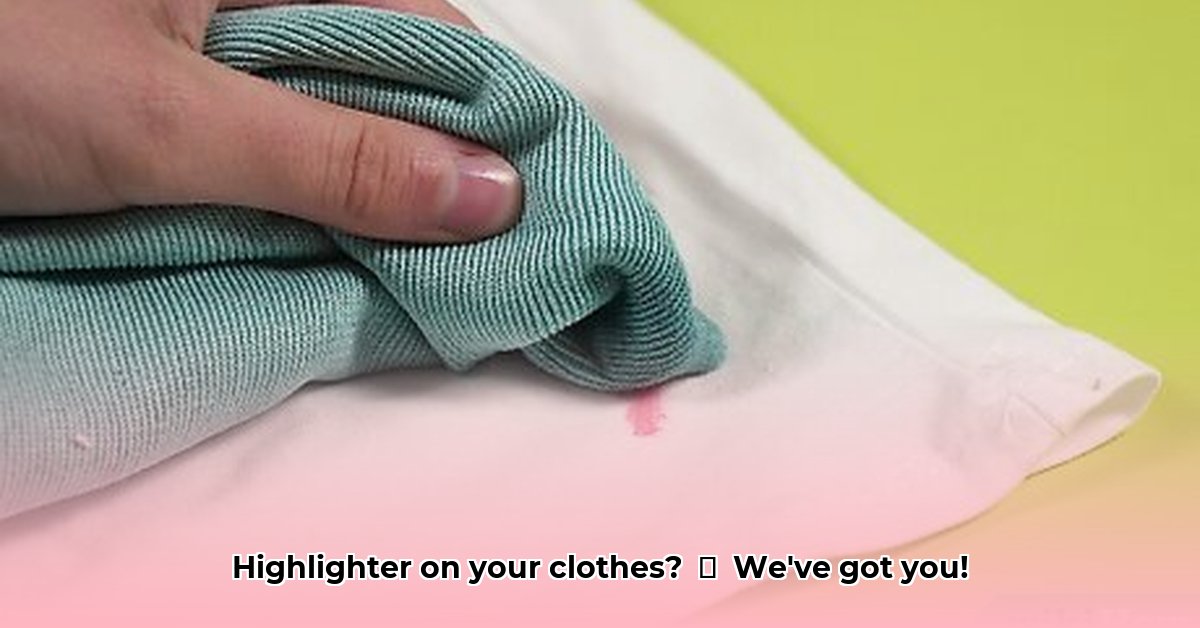Decoding the Stain: Ink and Fabric Dynamics
Highlighter inks, categorized as water-based (generally easier to remove) or alcohol-based (more stubborn), react differently with various fabrics. Natural fibers like cotton and linen, known for their absorbency, often respond better to cleaning than synthetics like polyester, which tend to hold onto stains. Understanding this interplay between ink and fabric is the cornerstone of effective stain removal. For instance, a water-based highlighter on cotton might be tackled with simple water rinsing, while an alcohol-based ink on polyester could necessitate a specialized stain remover. Identifying your fabric type before treatment is paramount. For stubborn adhesive stains, check out these tips for glue removal.
Emergency Response: Removing Fresh Highlighter Marks
Time is of the essence with fresh highlighter stains. Swift action significantly increases the likelihood of complete removal, preventing the ink from deeply embedding into the fabric fibers.
- Blot, Don’t Rub: The golden rule of stain removal: gentle blotting with a clean cloth or paper towel absorbs excess ink without spreading. Rubbing, on the other hand, forces the stain deeper, widening the affected area. Imagine blotting as gently lifting the ink, while rubbing is like smearing paint on a canvas.
- Alcohol Power: Isopropyl alcohol (70% concentration) or a hand sanitizer with a high alcohol content acts as a potent solvent, breaking down the ink. Apply directly to the stain, blotting continuously with a clean cloth beneath to absorb the dissolved ink. Remember to test on a hidden area first, as alcohol can affect certain dyes.
- Rinse and Repeat: Rinse the treated area thoroughly with cool water. Repeat steps 1 and 2 as necessary, observing the stain’s gradual fading. Patience is key; multiple treatments may be necessary for stubborn stains.
- Launder as Usual: Once the stain is significantly diminished, wash the garment according to its care label instructions. This final step helps remove any residual ink and cleaning agents.
Battling Set-In Stains: A Strategic Approach
Set-in highlighter stains, having bonded with the fabric, demand a more strategic approach. Pre-treating before washing becomes crucial for breaking down the ink’s hold.
- Detergent Power: Apply a small amount of liquid laundry detergent directly onto the stain, gently working it into the fibers with your fingers or a soft-bristled brush. Detergent acts as a surfactant, loosening the ink’s grip.
- Baking Soda Paste: Create a paste by mixing baking soda with a small amount of water. Apply a thick layer over the stain, allowing it to sit for at least 30 minutes. Baking soda, a mild alkali, helps lift and neutralize the stain. For enhanced effectiveness, cover the paste with plastic wrap to prevent drying.
- Vinegar Boost (Caution!): While vinegar can be effective, exercise caution. Always test white vinegar on an inconspicuous area first to ensure colorfastness. If safe, apply the vinegar directly to the stain before applying the baking soda paste. The combination of vinegar’s acidity and baking soda’s alkalinity creates a mild effervescence that can further loosen the stain.
- Rinse and Wash: Rinse the treated area thoroughly with cool water to remove the detergent and baking soda paste. Then, launder the garment as usual, following the care label instructions.
Fabric-Specific Care: Handling Delicates with Precision
Fabric type dictates the cleaning approach. Delicate materials like silk, wool, or lace require special attention, often necessitating professional cleaning to prevent damage. Always consult the garment’s care label before attempting any DIY stain removal method.
For delicate fabrics, if a gentle blotting with isopropyl alcohol doesn’t suffice, consider a specialized stain remover designed for delicate materials or consult a professional cleaner. Harsh chemicals or aggressive scrubbing can irreparably damage these fabrics.
Stain Removal Strategies: Matching Method to Material
Different cleaning methods exhibit varying effectiveness depending on the stain’s age, the ink type, and the fabric. While rubbing alcohol excels at tackling fresh stains on robust fabrics, it may be less effective on set-in stains or unsuitable for delicates. Baking soda paste, while gentler, might require longer application times. Understanding these nuances empowers you to choose the most appropriate method for your specific situation.
Essential Tips for Highlighter Stain Removal Success
- Immediate Action: The sooner you address a stain, the easier it is to remove.
- Blot, Don’t Rub: Blotting prevents the stain from spreading and setting deeper.
- Test Before You Treat: Always test cleaning solutions on a hidden area to prevent damage.
- Fabric Awareness: Consider the fabric type and its care instructions before choosing a cleaning method.
- Persistence Pays: Some stains require multiple treatments. Don’t be discouraged if the stain doesn’t disappear immediately.
By understanding the science behind stain removal and exercising patience, you can effectively conquer highlighter stains and keep your clothes looking their best.
- Call of Duty Not Launching Steam? Get Your Game Running Again - December 23, 2025
- Cod Not Launching On Steam? Troubleshoot Common Game Start Issues - December 22, 2025
- Game Installation Problems Often Require Smart Troubleshooting For Smooth Gaming - December 21, 2025







